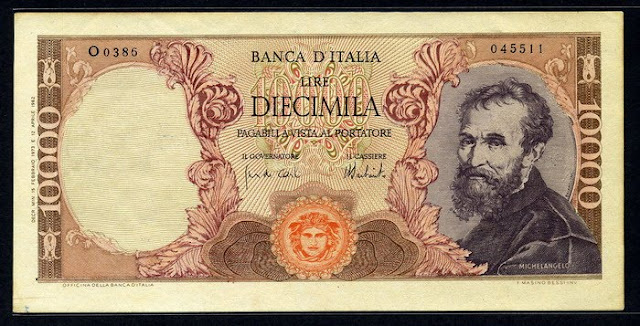 |
| 10000 Italian lire, Michelangelo Buonarroti |

Currency of Italy 10000 Lire banknote of 1973 Michelangelo Buonarroti
Bank of Italy - Banca d'Italia
Bank of Italy - Banca d'Italia
Obverse: Portrait of Michelangelo Buonarroti.
Reverse: At the centre, a view of the Piazza del Campidoglio in Rome, designed by Michelangelo Buonarroti.
Italian banknotes and paper money from Italy
1962-1974 Issue
1000 Lire 5000 Lire 10000 Lire 50000 Lire 100000 Lire
Banknotes of Italy - 10000 Lire
Michelangelo di Lodovico Buonarroti Simoni (6 March 1475 – 18 February 1564) was an Italian sculptor, painter, architect, and poet of the High Renaissance who exerted an unparalleled influence on the development of Western art. Considered to be the greatest living artist during his lifetime, he has since been described as one of the greatest artists of all time. Despite making few forays beyond the arts, his versatility in the disciplines he took up was of such a high order that he is often considered a contender for the title of the archetypal Renaissance man, along with his rival and fellow Florentine Medici client, Leonardo da Vinci.
A number of Michelangelo's works of painting, sculpture, and architecture rank among the most famous in existence. His output in every field of interest was prodigious; given the sheer volume of surviving correspondence, sketches, and reminiscences taken into account, he is the best-documented artist of the 16th century.
He sculpted two of his best-known works, the Pietà and David, before the age of thirty. Despite holding a low opinion of painting, Michelangelo also created two of the most influential frescoes in the history of Western art: the scenes from Genesis on the ceiling of the Sistine Chapel in Rome, and The Last Judgment on its altar wall. As an architect, Michelangelo pioneered the Mannerist style at the Laurentian Library. At the age of 74, he succeeded Antonio da Sangallo the Younger as the architect of St. Peter's Basilica. Michelangelo transformed the plan so that the western end was finished to his design, as was the dome, with some modification, after his death.
Michelangelo was unique as the first Western artist whose biography was published while he was alive. In fact, two biographies were published during his lifetime; one of them, by Giorgio Vasari, proposed that he was the pinnacle of all artistic achievement since the beginning of the Renaissance, a viewpoint that continued to have currency in art history for centuries.
In his lifetime he was often called Il Divino ("the divine one"). One of the qualities most admired by his contemporaries was his terribilità, a sense of awe-inspiring grandeur. The attempts by subsequent artists to imitate Michelangelo's impassioned and highly personal style resulted in Mannerism, the next major movement in Western art after the High Renaissance.
Piazza del Campidoglio in Rome, designed by Michelangelo Buonarroti
The existing design of the Piazza del Campidoglio and the surrounding palazzi was created by Renaissance artist and architect Michelangelo Buonarroti in 1536–1546. At the height of his fame, he was commissioned by the Farnese Pope Paul III, who wanted a symbol of the new Rome to impress Charles V, who was expected in 1538. This offered him the opportunity to build a monumental civic plaza for a major city as well as to reestablish the grandeur of Rome. Michelangelo's first designs for the piazza and remodeling of the surrounding palazzi date from 1536. His plan was formidably extensive. He accentuated the reversal of the classical orientation of the Capitoline, in a symbolic gesture turning Rome’s civic center to face away from the Roman Forum and instead in the direction of Papal Rome and the Christian church in the form of St. Peter’s Basilica. This full half circle turn can also be seen as Michelangelo’s desire to address the new, developing section of the city rather than the ancient ruins of the past. An equestrian statue of Marcus Aurelius was to stand in the middle of the piazza set in a paved oval field. Michelangelo was required to provide a setting for the statue and to bring order to an irregular hilltop already encumbered by two crumbling medieval buildings set at an acute angle to one another. The Palazzo del Senatore was to be restored with a double outer stairway, and the campanile moved to the center axis of the palace. The Palazzo dei Conservatori was also to be restored, and a new building, the so-called Palazzo Nuovo, built at the same angle on the north side of the piazza to offset the Conservatori, creating a trapezoidal piazza. A wall and balustrade were to be built at the front of the square, giving it a firm delineation on the side facing the city. Finally, a flight of steps was to lead up to the enclosed piazza from below, further accentuating the central axis.
The sequence, Cordonata piazza and the central palazzo are the first urban introduction of the "cult of the axis" that was to occupy Italian garden plans and reach fruition in France.
Executing the design was slow: Little was actually completed in Michelangelo's lifetime (the Cordonata Capitolina was not in place when Emperor Charles arrived, and the imperial party had to scramble up the slope from the Forum to view the works in progress), but work continued faithfully to his designs and the Campidoglio was completed in the 17th century, except for the paving design, which was to be finished three centuries later.